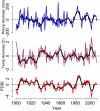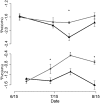The roles of hydraulic and carbon stress in a widespread climate-induced forest die-off
- PMID: 22167807
- PMCID: PMC3252909
- DOI: 10.1073/pnas.1107891109
The roles of hydraulic and carbon stress in a widespread climate-induced forest die-off
Abstract
Forest ecosystems store approximately 45% of the carbon found in terrestrial ecosystems, but they are sensitive to climate-induced dieback. Forest die-off constitutes a large uncertainty in projections of climate impacts on terrestrial ecosystems, climate-ecosystem interactions, and carbon-cycle feedbacks. Current understanding of the physiological mechanisms mediating climate-induced forest mortality limits the ability to model or project these threshold events. We report here a direct and in situ study of the mechanisms underlying recent widespread and climate-induced trembling aspen (Populus tremuloides) forest mortality in western North America. We find substantial evidence of hydraulic failure of roots and branches linked to landscape patterns of canopy and root mortality in this species. On the contrary, we find no evidence that drought stress led to depletion of carbohydrate reserves. Our results illuminate proximate mechanisms underpinning recent aspen forest mortality and provide guidance for understanding and projecting forest die-offs under climate change.
Conflict of interest statement
The authors declare no conflict of interest.
Figures




References
-
- Bonan GB. Forests and climate change: Forcings, feedbacks, and the climate benefits of forests. Science. 2008;320:1444–1449. - PubMed
-
- Sabine CL, et al. In: The Global Carbon Cycle: Integrating Humans, Climate, and the Natural World. Field CB, Raupach MR, editors. Washington, DC: Island; 2004.
-
- Allen CD, Breshears DD. Climate-induced forest dieback as an emergent global phenomenon. Eos Trans AGU. 2007;88:47–54.
-
- McDowell N, et al. Mechanisms of plant survival and mortality during drought: why do some plants survive while others succumb to drought? New Phytol. 2008;178:719–739. - PubMed
-
- Allen CD, et al. A global overview of drought and heat-induced tree mortality reveals emerging climate change risks for forests. For Ecol Manage. 2010;259:660–684.
Publication types
MeSH terms
Substances
LinkOut - more resources
Full Text Sources
Other Literature Sources
Molecular Biology Databases

